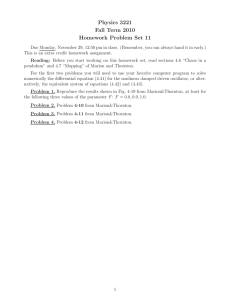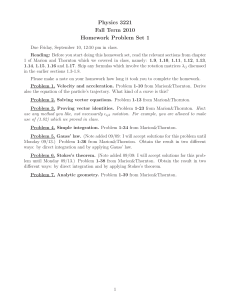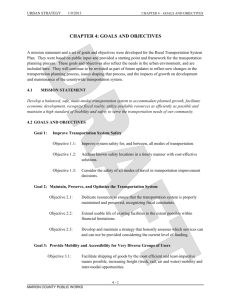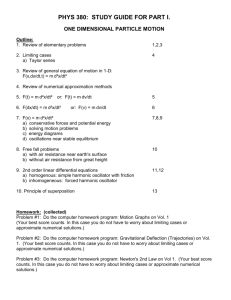HW 8 solution
advertisement
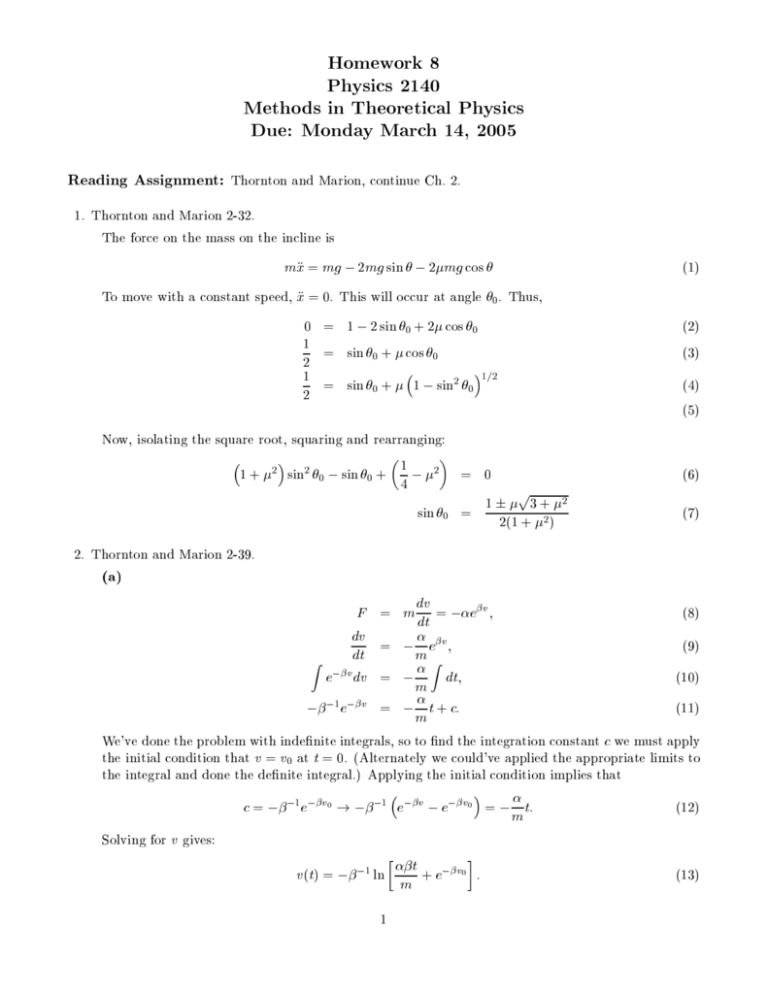
Homework 8
Physics 2140
Methods in Theoretical Physics
Due: Monday March 14, 2005
Reading Assignment: Thornton and Marion, continue Ch. 2.
1. Thornton and Marion 2-32.
The force on the mass on the incline is
mx = mg , 2mg sin , 2mg cos To move with a constant speed, x = 0. This will occur at angle 0 . Thus,
0 = 1 , 2 sin 0 + 2 cos 0
1 = sin + cos 0
0
2
1 = sin + 1 , sin2 1=2
0
0
2
Now, isolating the square root, squaring and rearranging:
1
2
2
2
1 + sin 0 , sin 0 + 4 , = 0
p
2
1
sin 0 = 2(1 +3+2 )
(1)
(2)
(3)
(4)
(5)
(6)
(7)
2. Thornton and Marion 2-39.
(a)
v
F = m dv
dt = ,e ;
dv = , ev ;
dt
mZ
Z
dt;
,
v
e dv = , m
, ,1 e,v = , m t + c:
(8)
(9)
(10)
(11)
We've done the problem with indenite integrals, so to nd the integration constant c we must apply
the initial condition that v = v0 at t = 0. (Alternately we could've applied the appropriate limits to
the integral and done the denite integral.) Applying the initial condition implies that
Solving for v gives:
t:
c = , ,1 e,v0 ! , ,1 e,v , e,v0 = , m
v(t) = , ,1 ln
1
t + e,v0 :
m
(12)
(13)
(b) Solve for t when v = 0:
t + e,v0 = 1 ! t = m 1 , e,v0 :
m
(c) Start with equation (13):
dx = , ,1 ln
(14)
t + e,v0 dt:
m
(15)
Using the fact that (from a table of integrals or mathematica):
Z
ln(at + b)dx = at + b ln(at + b) , t;
(16)
a
we get:
2
3
t + e,v0 ln t + e,v0
1
m
, t5
x + c = , 4 m
=m
(17)
Applying the initial condition that x = 0 at t = 0 to nd c we get:
0 m ,v0
c = v
e ;
mv
t
m
t
t
0 ,v0
,
v
,
v
0
0
x(t) = , e + , 2 m + e
ln m + e
:
Substituting the time required to stop (eqn. 14), gives the distance required to stop:
x = m 1 , e,v0 v + 1 :
0
(18)
(19)
(20)
3. Thornton and Marion 2-54.
(a) The terminal speed means that the nal speed is constant, or the net force is zero: mg =
kmv ! v = g=k = 10=:01 980 m/s.
(b)
dv = F = ,(g)kv) ! dx = dt = , dv
dt
m
v
g + kv
Zx
Z0
v0 + g ln g 680 m:
!
x
=
dx0 = , g vdv
+ kv
k k2 g + kv
0
v0
0
(21)
(22)
Energy Problems:
4. Thornton and Marion 2-25 (a) - (c).
(a) The track counters the force of gravity and, importantly, centripetal acceleration. In polar
coordinates centered at the center of the circular arc around point A, the radial component of
Newton's second law tells us that:
mar = m(r , r_ 2) = mg , N:
(23)
2
y
h
R
o
45
B
h’
A
x
Figure 1: Geometry for problem #4.
Note the signs on the right hand side of equation (23). Gravity points in the positive r direction and
is, therefore, positive and the normal force N points in the negative radial direction and is negative.
Near point A, the block moves along the arc of a circle so r = 0, r = R, and _ = ! = v=R. Thus,
mv :
=
mg
,
N
)
N
=
mg
+
, mv
R
R
2
2
(24)
To nish the derivation, we need to express v in terms of h by using the conservation of energy:
(25)
Etop = Utop = mgh = EA = UA + KA = 0 + 21 mv2 ) v2 = 2gh:
From equations (24) and (25) we see that:
N = mg + m 2gh = mg 1 + 2h :
(26)
R
R
(b) Similarly, at point B
mg
p mv
N = mg cos + mv
R = + R
2
2
2
To nd N we need to nd v using conservation of energy again:
E = mgh = 21 mv2 + mgh0 = 21 mv2 + mg R , pR ) v2 = 2g h , R 1 , p1 :
2
2
(27)
(28)
p
The following gure helps to see that h0 = R , R= 2.
Thus,
mg
2
gm
1
2
h
3
N = p + R h , R 1 , p = mg r + p , 2
2
2
2
(29)
(c) From equation (28) we see that
s
1
v = 2g h , R 1 , p :
2
3
(30)
0
R (cos 45) = R/√2
R
45
B
R - R/√2 = h’
A
5. Thornton and Marion 2-43.
In discussing the motion of the particle, clearly indicate at what energies the particle is free (or
unbound), trapped, and where the stable and unstable equilibrium points are. Please make sure to
plot { although Marion does not ask you to do so.
R
F = ,kx + kx3 =2 ! U (x) = , F (x)dx = 21 kx2 , 14 k x42 .
The gure on the last page of the homework solutions presents a computer plot of U (x). You don't
need to plot this potential with a computer for this assignment, however. Merely note that near
x = 0, U (x) behaves like the parabola kx2=2, which is concave
up and possesses a minimum at the
1 x4
origin. For very large values of x, it behaves like , 4 k 2 , which goes to negative innity. Thus,
U (x) displays two maxima, symmetrically distributed on either side of the origin. The location of
the three extrema, are roots of the following equation:
dU = 0 ! 0 = kx , k x3 ! x = 0; :
(31)
dx
2
Thus, in addition to the stable equilibrium point at x = 0, the two unstable equilibria are at x = .
To check for stability/instability, note that at x = 0, d2 U=dx2 = k > 0, so that x = 0 is a stable
equilibrium point, but at x = , d2 U=dx2 = ,2k < 0, so x = are points of unstable equilibrium.
Note that at x = (points 4 and 7) on the graph, U () = E1 = k2 =4. pThus, k2 =4 is the
potential energy of the unstable equilibrium points. Note that U = 0 at x = 2 (points 2 and 9
on the graph) and at the origin.
If E0 is everywhere greater than k2 =4, then the particle is free.
If E1 = k2 =4, then the particle is unbound everywhere except at x = (points 4 and 7), where it
is in unstable equilibrium.
For 0 < E2 < k2 =4, the particle is free to move in the ,x direction if x is less than point 3, in the
+x direction if x is greater than point 8, and is bound if x lies between points 5 and 6. It is forbidden
to exist between points 3 and 5 and 6 and 8.
p
For E3 p
= 0, the particle is free to move in the ,x direction if x < , 2 (point 2), in the +x direction
if x > 2p(point 9), and is in stable equilibrium at the origin. It is forbidden to exist anywhere
between 2 (points 2 and 9) except at the origin.
If E4 < 0, the particle is forbidden between points 1 and 10, but is free to move in the ,x direction
if x is less than point 1 and in the +x direction if x is greater than point 10.
4
Marion and Thornton, #2-43.
U(x)
E0
E1
E2
E3 = 0
1
3
5
6
4
8
7
2
9
E4
0
Figure 2: Plot for problem Marion and Thornton #2.43.
5
10
x
